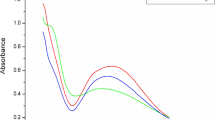Abstract
Antifungal properties were introduced in nonwoven regenerated cellulose (RC) nanofibrous membrane using Quillaja saponin. To generate cellulose membranes, deacetylation of electrospun cellulose acetate (CA) nanofibrous membranes was performed using 0.05 M NaOH and ethanol for membranes both loaded and unloaded with Quillaja saponin. Chemical and physical properties of nonwoven CA and RC nanofibrous membrane were characterized using scanning electron microscopy, attenuated total reflectance–Fourier transform infrared spectroscopy, differential scanning calorimetry, and tensile properties. Our results showed that saponin doping did not affect the morphology of the resulting fibers and that the membrane structure was maintained during deacetylation. The antifungal properties of saponin-loaded fabric were determined at 0 and 24 h against two household fungi, Penicillium roguefortii and Aspergillus ochraceus, and compared with control samples. Our findings show that after 24 h the saponin-loaded fabrics had spores kill of 80.4% and 53.6% for P. roguefortii and A. ochraceus, respectively. Fabric containing Quillaja saponin has potential for household applications and could be evaluated further for medical applications.






Similar content being viewed by others
References
Avato P, Bucci R, Tava A, Vitali C, Rosato A, Bialy Z et al (2006) Antimicrobial activity of saponin from Medicago sp.: structure-activity relationship. Phytother Res 20:454–457
Bankefors J, Nord LI, Kenne L (2008) Structural classification of Quillaja saponins by electrospray ionization ion trap multiple-stage mass spectrometry in combination with multivariate analysis: proof of concept. Chemometr Intell Lab 90:178–187
Barile E, Bonanomi G, Antignani V, Zolfaghari B, Sajjadi SE, Scala F et al (2007) Saponin from Allium minutiflorum with antifungal activity. Phytochemistry 68:596–603
De Lucca AJ, Boue S, Palmgren MS, Maskos K, Cleveland TE (2006) Fungicidal properties of two saponin Capsicum frutescens and the relationship structure and fungicidal activity. Can J Microbiol 52:336–342
Flannigan B, McCabe EM, McGarry F (1991) Allergenic and toxigenic micro-organisms in houses. J Appl Bacteriol 70(Suppl):61S–73S
Gao Y, Cranston R (2008) Recent advances in antimicrobial treatments of textiles. Text Res J 78:60–72
Ghanbari KH, Bathaie SZ, Mousavi MF (2008) Electrochemically fabricated polypyrrole nanofiber-modified electrode as a new electrochemical DNA biosensor. Biosens Bioelectron 23:1825–1831
Gibson P, Schreuder-Gibson H, Stote R, Roylance M, Nakagawa M, Capone C (2008) Effect of nanofibers on spore penetration and lunar dust filtration. J Eng Fiber Fabr 3:19–28
Higuchi R, Komori T (1987) Structures of compounds derived from the acyl moieties of Quillajasaponin. Phytochemistry 26:2357–2360
Kalyon BD, Olgun U (2001) Antibacterial efficacy of triclosan-incorporated polymers. Am J Infect Control 29:124–125
Korpi A, Pasanen A-L, Pasanen P (1998) Volatile compounds originating from mixed microbial cultures on building materials under various humidity conditions. Appl Environ Microbiol 64:2914–2919
Lim SH, Hudson SM (2004) Application of a fiber-reactive chitosan derivative to cotton fabric as an antimicrobial textile finish. Carbohydr Polym 56:227–234
Liu HQ, Hsieh YL (2002) Ultrafine fibrous cellulose membranes from electrospinning of cellulose acetate. J Polym Sci B 40:2119–2129
Ma K, Chan CK, Liao S, Hwang WYK, Feng Q, Ramakrishna S (2008) Electrospun nanofiber scaffolds for rapid and rich capture of bone marrow-derived hematopoietic stem cells. Biomaterials 29:2096–2103
Manuel RJ, Kibbler CC (1998) The epidemiology and prevention of invasive aspergillosis. J Hosp Infect 39:95–109
Rabea EI, Badawy ME, Stevens CV, Smagghe G, Steurbaut W (2003) Chitosan as antimicrobial agent: applications and mode of action. Biomacromolecules 4:1457–1465
Sparg SG, Light ME, van Staden J (2004) Biological activities and distribution of plant saponins. J Ethnopharmacol 94:219–243
Tan K, Obendorf SK (2007) Fabrication and evaluation of electrospun nanofibrous antimicrobial nylon 6 membranes. J Membr Sci 305:287–298
Wilkins K, Larsen K (1995) Variation of volatile organic compound patterns of mold species from damp buildings. Chemosphere 31:3225–3236
Yang C-R, Zhang Y, Jacob MR, Khan SI, Zhang Y-J, Li X-C (2006) Antifungal activity of C-27 steroidal saponins. Antimicrob Agents Chemother 50:1710–1714
Yazdankhah SP, Scheie AA, Hoiby EA, Lunestad B-T, Heir E, Fotland TO et al (2006) Triclosan and antimicrobial resistance in bacteria: An overview. Microb Drug Resist 12:83–90
Yuan J, Liu X, Akbulut O, Hu J, Suib SL, Kong J et al (2008) Superwetting nanowire membranes for selective absorption. Nat Nanotechnol 3:332–336
Acknowledgments
Funding was provided the National Textile Center United States (Project No. C05-CR01); Intelligent Textile System Research Center at Seoul National University; and Cornell University Agricultural Experiment Station federal formula funds, Project No. NYC-329407, from Cooperative State Research, Education, and Extension Service, United States Department of Agriculture. Thanks also are extended to Yong Joo and Margaret Frey for use of the electrospinning equipment. Ana Leticia Ferreira Bertolo, from the Department of Plant Biology at Cornell University, is highly acknowledged for assistance with the fungus experiment. This work was also supported by the Cornell Center for Materials Research, a Materials Research Science and Engineering Center of the National Science Foundation (Grant No. DMR-0520404).
Author information
Authors and Affiliations
Corresponding author
Rights and permissions
About this article
Cite this article
Dixit, V., Tewari, J. & Obendorf, S.K. Fungal Growth Inhibition of Regenerated Cellulose Nanofibrous Membranes Containing Quillaja Saponin. Arch Environ Contam Toxicol 59, 417–423 (2010). https://doi.org/10.1007/s00244-010-9493-6
Received:
Accepted:
Published:
Issue Date:
DOI: https://doi.org/10.1007/s00244-010-9493-6




